1. Deep-Dish Pizza
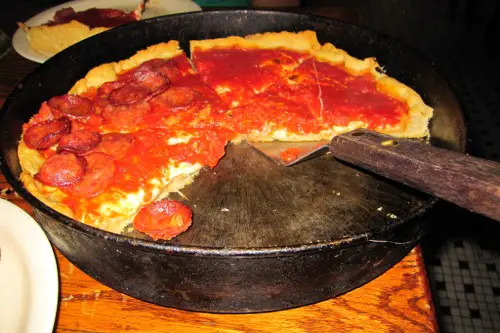
American pizza—especially that gooey, cheesy, deep-dish or New York-style slice—is a far cry from its Neapolitan ancestor. In Italy, traditional pizza is thin, light on toppings, and all about balance, but American tastes went in a completely different direction. Immigrants found that their old recipes didn’t quite cut it here, so they piled on more cheese, amped up the sauce, and sized everything up. The result was a new beast entirely: pizza as a hearty, indulgent comfort food.
The shift wasn’t just culinary—it was cultural. Americans wanted something fast, filling, and affordable, and the reinvented pizza delivered. What started as a modest street food became a nationwide obsession, with cities competing for who could make the biggest, baddest pie. It’s hard to imagine Super Bowl Sunday without it, but this version of pizza wouldn’t exist without rejecting its Italian blueprint.
2. General Tso’s Chicken
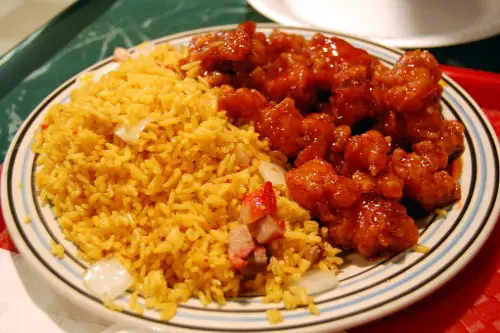
If you went looking for General Tso’s Chicken in China, you’d probably come up empty-handed. It was inspired by Hunanese cuisine, which is known for being hot and spicy, but the original Chinese dishes were nothing like the sweet, deep-fried version we know in the U.S. Chinese chefs who immigrated to America realized their bold, vinegar-heavy, chili-laced dishes weren’t exactly crowd-pleasers. So they dialed back the heat, added sugar, and created something totally new.
The result? A dish that hit the perfect balance of sweet, savory, and crunchy for American palates. It took the name of a real Hunan general but had little to do with his culinary heritage. Still, it’s become a staple of American Chinese takeout—an icon born from a cultural pivot.
3. Chop Suey

Chop Suey is the poster child of Chinese-American invention—and it likely never existed in China. It’s believed to have been created by Chinese immigrants in California who wanted to serve something resembling Chinese food using ingredients available in the U.S. Traditional Chinese dishes were too foreign or intense for American diners in the 19th century, so cooks improvised. They threw together meat, veggies, and a thick sauce, hoping to appeal to more Americanized tastes.
And somehow, it worked. Chop Suey caught on big-time, especially in the early 1900s, when it was marketed as “exotic” but not too exotic. It became one of the first Chinese dishes embraced by mainstream America. Without rejecting the more authentic, regional Chinese flavors, this dish wouldn’t have become the gateway to Chinese cuisine for so many.
4. Spaghetti and Meatballs
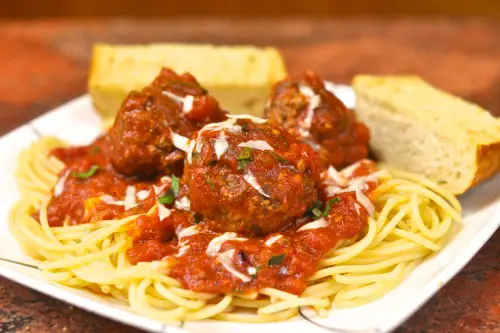
You won’t find spaghetti and meatballs served together in Italy, at least not in the way we do it. Italians treat meatballs, or polpette, as a separate dish, often served plain or in broth, and pasta is usually dressed more simply. But Italian immigrants in the U.S. wanted to make their meals heartier, especially for growing families on tight budgets. So they mashed two separate ideas together—meatballs and pasta—and gave it a healthy dose of tomato sauce.
The dish took off because it was affordable, filling, and comforting. Italian-American cooks were cooking for survival and adaptation, not tradition. By Americanizing the portions and combining elements never meant to be paired, they created a beloved comfort food classic. Today, it’s so iconic people forget it was ever a culinary mismatch.
5. Fortune Cookies

Fortune cookies aren’t Chinese—they’re actually Japanese in origin and were first popularized in California. The original version was more subtly flavored and didn’t contain a fortune, but when Japanese-Americans were interned during World War II, Chinese-American businesses adopted and adapted the treat. They sweetened it, added the paper fortune, and began serving it in Chinese restaurants. The version we know today was a fusion born out of necessity and reinvention.
Ironically, most people associate it with authentic Chinese cuisine. But ask anyone in China, and they’ll likely tell you they’ve never seen one. It’s a uniquely American tradition that came from reshaping a quiet Japanese snack into something more theatrical and fun. All because the original recipe—and culture—was sidelined in wartime America.
6. Macaroni and Cheese

Mac and cheese has European roots, sure—France and Italy both had versions—but the American version is its own thing entirely. In Europe, you might find baked pasta with béchamel or subtle cheeses, but when Kraft boxed it up in the 1930s, it was all about convenience and cost. Americans didn’t just tone down the fancy sauce—they ditched it altogether in favor of processed cheese powder and elbow noodles. The result was a pantry staple during the Great Depression and World War II.
This stripped-down version wouldn’t fly in a French kitchen, but that’s exactly why it thrived here. It was cheap, easy, and could feed a family in minutes. It became the ultimate comfort food, especially for kids, and remains a nostalgic favorite today. All because traditional versions were too time-consuming or pricey for everyday American life.
7. Bagels with Cream Cheese and Lox

Traditional Eastern European bagels were much plainer, smaller, and usually eaten without toppings. Jewish immigrants brought bagels to the U.S., but it was American culture that dressed them up with cream cheese and smoked salmon. The idea of pairing bagels with dairy and fish was unfamiliar—even controversial—for Old World palates. But American markets and tastes favored bold, rich combos, so the bagel got a makeover.
It caught on in New York, particularly among the Jewish community, and soon became a brunch staple across the country. The addition of capers, onions, and tomatoes only further Americanized it. Bagels themselves might be Old World, but their modern presentation is pure American improvisation. Reworking humble bread into a gourmet breakfast took letting go of tradition first.
8. Chili Con Carne

Chili has roots in Mexican cuisine, but what we know as chili con carne—ground beef, beans, tomatoes, and spices—is not something you’d find in traditional Mexican kitchens. Early Mexican dishes used more subtle combinations of dried chilies and meats, but American cowboys and settlers in Texas simplified and spiced things up. They added ground beef and beans to stretch the dish, making it a working-class meal that was filling and bold. Mexicans generally reject the use of beans in traditional chili, which makes American chili something entirely new.
This Tex-Mex mashup became a point of pride in the American Southwest. Chili cook-offs and secret spice blends turned it into a competition food. It’s hearty, flavorful, and distinctly American, born out of rejecting the complexity of traditional Mexican recipes. The result was something unique that still sparks debates today.
9. Buffalo Wings
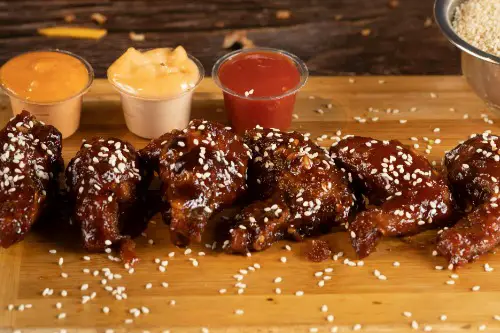
Chicken wings weren’t exactly prime meat cuts in classic French or Italian cooking. In fact, they were often discarded or used for stocks. But in 1964, at Anchor Bar in Buffalo, New York, leftover wings got tossed in hot sauce and butter as a last-minute bar snack. The original idea likely wouldn’t have passed muster in traditional European kitchens, where sauces are carefully balanced and wings were never considered showstoppers.
Americans, however, loved the mess, the heat, and the hands-on experience. It spread like wildfire across sports bars and game-day menus. Buffalo wings became a national obsession precisely because they broke the rules. Sometimes, turning scraps into a star just takes a little rebellion.
10. Cornbread

European settlers didn’t quite know what to do with cornmeal when they first arrived—wheat was their go-to grain. Native Americans had long used corn as a staple, but early European-style breads failed when made with cornmeal alone. So, colonists adapted, creating new recipes that mixed cornmeal with milk, eggs, and fat to make something entirely different: cornbread. It wasn’t the fluffy loaf bread they were used to, but it worked.
This fusion of Old World techniques and Native American ingredients became a Southern staple. Over time, it evolved into sweet or savory versions, depending on the region. Cornbread is a perfect example of how ditching a European recipe led to something deeply American. It’s a cultural hybrid born out of sheer necessity—and it’s delicious.
11. Sloppy Joes
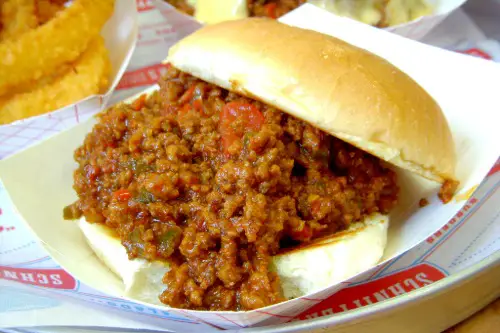
You won’t find anything quite like a Sloppy Joe in European cuisine, where ground meat is usually reserved for more refined dishes. Originating in the early 20th century, this loose meat sandwich combined ground beef, tomato sauce, sugar, and spices into a messy, meaty comfort food. It may have been inspired by Italian meat sauces, but Americans weren’t looking for pasta—they wanted something handheld. The dish took off during the Great Depression thanks to its low cost and easy prep.
The idea of mixing meat and sugar would horrify many traditional cooks from abroad. But American palates grew to love the sweet-savory combination. Sloppy Joes became cafeteria staples and a symbol of quick, satisfying meals. A rejected sauce became an all-American icon in a bun.
12. Casseroles

Casseroles came from the idea of one-pot meals, which exist around the world, but the American version became something entirely different. In Europe, such dishes might be stews or layered vegetable bakes, but Americans added canned soup, shredded cheese, breadcrumbs, and whatever leftovers were in the fridge. Traditional French or Italian chefs would scoff at combining cream of mushroom soup with tuna and noodles. But mid-century America embraced convenience cooking with gusto.
Casseroles were a hit with post-WWII housewives looking for efficient, family-friendly meals. They became synonymous with potlucks, church suppers, and suburban dinners. What began as a far cry from elegant European cuisine became a defining dish of American home life. And it all started by rejecting the complexity of traditional recipes.
13. Hot Dogs
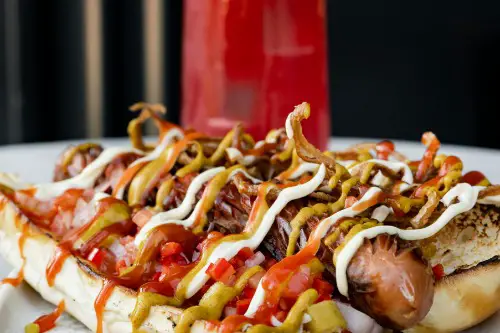
Sausages are everywhere in Europe—Germany especially—but the American hot dog is its own invention. German immigrants brought over bratwurst and frankfurters, but once they hit American cities, the sausage got slimmer, the casing softer, and the toppings louder. Instead of eating them with a knife and fork or pairing them with sauerkraut and mustard alone, Americans stuffed them into buns and started experimenting. Relish, onions, chili, cheese—you name it, we threw it on.
The hot dog cart, born from street vendors needing quick, cheap food, turned this humble sausage into a fast-food icon. Ballparks and fairs turned it into a national pastime. The old-world rules didn’t stick, and the result is a uniquely American street food. It may have German roots, but the hot dog as we know it is 100% red, white, and blue.
14. Philly Cheesesteak
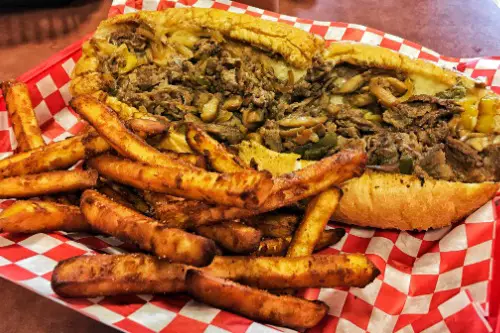
Philly cheesesteaks have roots in Italian sandwich culture, but you won’t find anything quite like them in Italy. In place of cured meats or cold cuts, cooks in Philadelphia began piling thinly sliced beef on hoagie rolls and smothering it in melted cheese—often Cheez Whiz. The Italian affinity for simplicity and fresh ingredients didn’t survive the journey intact; this was about indulgence and speed. The result was a greasy, gooey, entirely American sandwich that became a citywide staple.
No Italian chef would put processed cheese on a steak sandwich, but that’s what made the Philly cheesesteak iconic. It wasn’t trying to be elegant—it was meant to be devoured. The American twist on a classic meat sandwich reflects a shift toward bold, high-calorie, crowd-pleasing street food. This culinary invention thrived by tossing out Old World restraint in favor of full-throttle flavor.
15. Baked Ziti
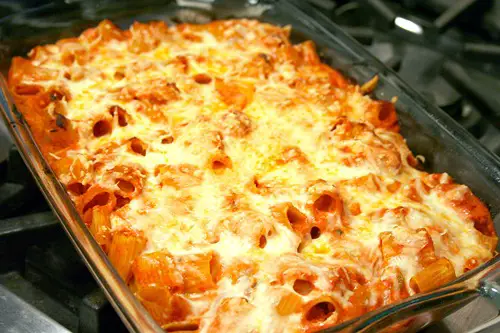
In Italy, baked pasta dishes like pasta al forno exist, but they’re usually reserved for special occasions and use minimal ingredients. American versions, however, took this idea and went full throttle—more cheese, more sauce, more meat, and lots more quantity. Baked ziti became a weeknight standby in Italian-American households, often made in oversized pans to feed families or a church potluck. Subtlety was traded for abundance and comfort.
What once was a delicate layered dish became an ooey-gooey casserole of melted mozzarella and tomato-drenched noodles. It’s filling, crowd-friendly, and unapologetically American in its scale. The humble ziti pasta became a blank canvas for meatballs, sausage, or whatever else was on hand. In tossing out the lighter, seasonal variations of Italian baked pasta, America created its own pasta powerhouse.
16. Sweet and Sour Chicken
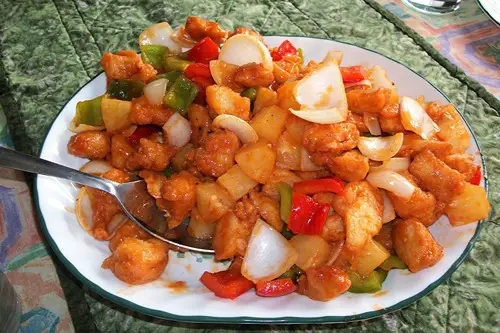
Traditional Chinese sweet and sour sauces are tangy and light, often made with vinegar and minimal sugar. But when the concept hit the U.S., it morphed into a thick, candy-colored glaze slathered over deep-fried chicken chunks. American diners preferred bolder, sweeter flavors, and Chinese-American chefs delivered. The result was something almost unrecognizable to Chinese natives, but instantly popular in American strip-mall restaurants.
It became a staple of the American Chinese menu—less about authenticity, more about flavor impact. Pineapple was often added, even though it wasn’t traditional, just to amp up the sweetness. This sugary, crispy dish came to represent “Chinese food” for an entire generation. Without rejecting the original subtler version, this neon-orange crowd-pleaser would never have existed.
17. Biscuits and Gravy

Scones and savory pastries existed in British cuisine, but the American South turned these into something heartier and far more indulgent. Instead of clotted cream or jam, American biscuits became a vessel for rich sausage gravy. British cooks might cringe at the use of peppery, fatty gravy poured over a flaky pastry—but Southerners turned it into a breakfast essential. It was a dish born from poverty, using cheap ingredients to create something filling.
The rejection of European formality gave rise to this comforting classic. It’s all about texture and flavor, not refinement. Biscuits and gravy represent Southern culinary creativity at its best—homey, generous, and unapologetically rustic. It’s proof that breaking the rules can lead to lasting traditions.
18. Fried Catfish
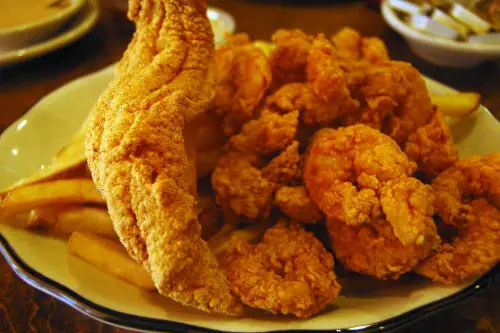
Catfish are eaten in many cultures, but American Southerners gave them a unique twist by deep-frying them in cornmeal batter. Unlike European or Asian fish preparations, which often focus on grilling or poaching, this version turned humble, bottom-feeding fish into a crispy, craveable dish. It was cheap, available, and perfect for frying—a technique not typically embraced in Old World cuisines for fish. The result was more texture, more crunch, and more community.
Fish fries became regional events, especially in the Mississippi Delta and beyond. Side dishes like hush puppies and coleslaw completed the plate, making it an American ritual. Frying catfish may have started out as a workaround, but it became a point of pride. It’s an example of Southern cooks creating something special by ignoring European standards of “delicacy.”
19. Egg Rolls

Egg rolls were born from the rejection of traditional Chinese spring rolls, which are typically thinner, lighter, and sometimes raw. Chinese-American chefs bulked them up with cabbage, pork, and carrots, then deep-fried them to a crisp. The original delicate rice-paper wrappers were swapped for thick, flour-based skins that held up better under frying. The result was a louder, crunchier, and distinctly American version.
You won’t find this kind of egg roll in a Beijing dim sum house. But in the U.S., it became a takeout essential, often served with sweet duck sauce on the side. It’s not subtle, but it’s fun, portable, and satisfying—qualities Americans tend to love in their snacks. In reimagining the spring roll, Chinese-American cooks created a new icon for the buffet line.
20. Grits with Cheese

Grits have Indigenous roots, originally made from ground corn by Native American tribes. When they made their way into Southern kitchens, European immigrants tried to adapt them to their own palates. Instead of serving them plain or with gravy, Americans—especially in the South—started adding cheddar cheese, butter, and sometimes even shrimp. The dish took on a creamy, savory, almost indulgent identity.
European corn dishes, like polenta, are more restrained and often used as a side. But cheese grits became a main event on Southern menus, especially at brunch. It’s another case of American ingenuity adding bold flavor where subtlety once ruled. Grits were never meant to be rich—but we made them that way, and we’re not sorry.
21. Ice Cream Sundaes

Europe gave the world gelato and delicate parfaits, but Americans wanted something messier, sweeter, and bigger. The ice cream sundae was born in drugstores around the late 1800s, when soda fountains looked for ways to avoid blue laws banning soda on Sundays. What started as a simple scoop of ice cream with syrup soon exploded into whipped cream, nuts, sprinkles, cherries, and candy. The original refined European desserts were tossed aside for maximalism.
The sundae became a symbol of American indulgence—fun, customizable, and over-the-top. While Europeans might prefer a single-flavor scoop, American diners embraced the “more is more” philosophy. Ice cream became a platform for creativity, not restraint. And thus, another Old World concept was joyfully flipped on its head.
This post 21 Iconic American Foods That Only Exist Because of Rejected Foreign Recipes was first published on American Charm.


